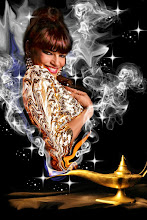Some dancers have a knack for creating, analyzing and
remembering choreographies; others…well, not so much! I've been getting a lot of emails asking for tips on self-creating dances and also retaining the steps in choreographies that others have written...so here are some tricks that
will help you work on your own, train yourself to remember sequencing and remember all the information in the dances that
others have created.
Creating Your Own Choreographies:
TRUST YOUR SUBCONCIOUS TO HELP YOU VISUALIZE MOVEMENT
Before making a set
choreography to a piece of music, let your “inner dancer” take over. Play the
music you want to work with and just improvise to it a few times. Chances are, your right brain will take
over and create lovely movement appropriate for the music you are hearing. The
right or artistic side of the brain is associated with expressing emotion,
listening to or creating music, recognizing faces, colors and images.
LOOK FOR THE PATTERNS
Once you’ve done some
improvisation with the music you’ve chosen to choreograph, you’ll probably
start to see patterns in your movement, so write them down and hone them into
“natural” combinations. Choreography
is never just a string of unrelated movements, so by working organically, you
will definitely see the relationship of each movement, which will help with the
flow and transitions. Take notes on what steps you’re using, so you will
remember them- you can always add on to them or embellish upon them later.
BREAK IT UP
Evaluate the structure of
your song, breaking it into segments such as Introduction, Verses, Choruses,
Bridge and Finale. If you’re working with a drum solo, do the same thing with
repeating patterns and rhythmic changes.
One you’ve divided the piece into segments, you’ll have a clear picture
of what needs to be repeated, or where you can add in variations. This way,
you’ll also have bite-sized chunks of the full song, and can work on each
section individually until it gets fully ingrained mentally and in your muscle
memory.
Memorizing Choreographies Created By Others:
REPETITION IS YOUR FRIEND
Don’t be shy about asking
your teacher, troupe director or the person who created a solo piece for you to
repeat sections as much as is necessary. Repetition will help you remember the
choreography physically and mentally. Drill the piece endlessly facing the
mirror, and away from it, so that
your muscle memory takes over.
CREATE NICKNAMES
FOR MOVEMENT
This seems a little wacky, but when we nickname a person, it
means we’re feeling comfortable and getting to know them. Same goes for
choreographies- calling each movement or section by an unforgettable and visual
name will actually help you become more familiar with it! Instead of something
like “sixteen counts of turning hip drops”, use a crazy title for the section
like “Slutty Genie”, "Weird Horror Movie Sequence" or “Michael Jackson Saidi”. It’s a trick that is actually a treat for the mind’s eye, and will help you to
remember each section.
USE EYE CONTACT AND BODY
AWARENESS
Both of these techniques will
help you to know where you need to be at any particular point in your group
choreography. Catch the eye of a troupe mate; be aware of distance and
placement as you form different patterns within the group.
For Any Type Of
Choreography, Group Or Solo:
Write everything down on the
spot, then type up the notes after you get home. This will not only give you
something to refer to, but the writing and copying will also help your brain
adapt to everything your body does.
Focus on just one aspect of the choreography each time you dance it. The
first time through concentrate on the footwork only, the second, third or
fourth time give attention to the arms, hips, upper body or whatever.
Once you feel comfortable
with the choreography, videotape yourself doing it, facing towards the camera
and away from it. You can also ask your teacher or choreographer to do the
same. Seeing the dance performed both ways will help you remember it fully, and
you’ll also be able to follow along exactly to the version done with the
performer’s back to the camera.
Last but not least, trust yourself. By relying too much on
your teacher, choreographer or troupe mates, you run the risk of being unable
to perform the piece by yourself!
You can do it!












No comments:
Post a Comment